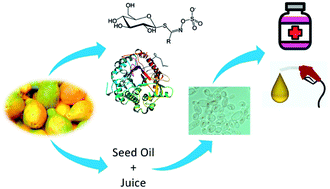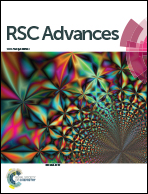Valorization of papaya fruit waste through low-cost fractionation and microbial conversion of both juice and seed lipids†
Abstract
Papaya (Carica papaya) is widely cultivated in many tropical regions of the world. With an estimated 30–50% cull rate, there is a large amount of off-grade papaya produced. Here, we report very low-cost processing of culled papaya fruit waste, without needing any complex mechanized operations, to yield several products, including seed oil, sugar-rich puree, detoxified/defatted seed meal, and crude myrosinase and glucosinolates with antimicrobial and biofumigation applications. We then demonstrated that both puree and seed oil can serve as effective carbon substrates for cultivation of the oleaginous yeast Yarrowia lipolytica to produce single-cell proteins and high-value recombinant protein products. To use papaya seed oil for culturing Y. lipolytica, the concentration of the inhibitory substance benzyl isothiocyanate (BITC) in the oil needs to be minimized. If the culled fruits (and hence seeds) were stored frozen prior to drying, a very high level (>30 mM) of BITC was detected in the oil extracted from the dried seeds. However, if the seeds were not frozen prior to drying, oil from dried papaya seeds contained almost no BITC, and could support vigorous growth of Y. lipolytica, with efficient production of a functional nanobody fusion protein at a level similar to that achieved using olive oil. By using both juice and seed lipid, rather than juice alone, Y. lipolytica biomass produced per unit papaya more than doubled. As Y. lipolytica is amenable to genetic manipulation, and is known as a proficient cell factory with many industrial applications, the papaya waste valorization technology could potentially be extended to produce additional useful products such as biofuel and oleochemicals from Y. lipolytica.



 Please wait while we load your content...
Please wait while we load your content...